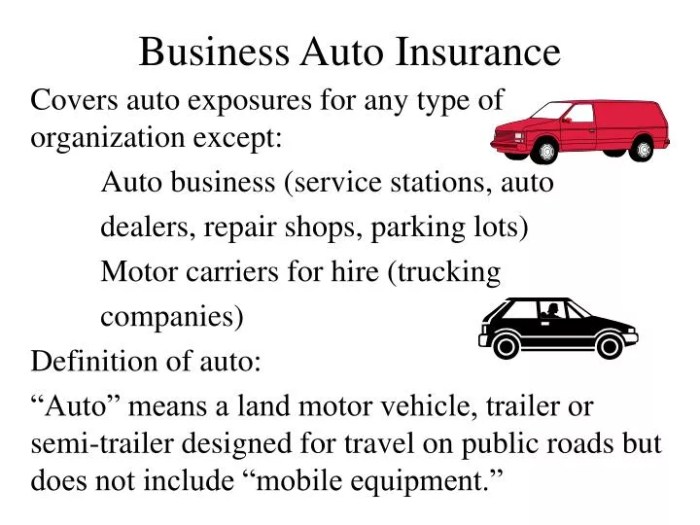The automotive industry is a dynamic landscape, filled with the thrill of innovation and the responsibility of safeguarding both your assets and your clients. Navigating this terrain requires a robust understanding of risk management, and a cornerstone of this is securing the right automotive business insurance. This guide delves into the multifaceted world of automotive business insurance, exploring the various policy types, factors influencing premiums, and strategies for minimizing risk, ultimately empowering you to make informed decisions that protect your business’s future.
From the intricacies of commercial auto insurance to the specialized coverages needed for unique automotive businesses, we’ll unravel the complexities and provide clear, actionable insights. We’ll explore how factors like your vehicle type, driver history, and business location impact your premiums, offering hypothetical scenarios to illustrate the financial implications of your choices. Furthermore, we’ll guide you through the claims process, provide effective risk management strategies, and assist in selecting the right insurance provider to meet your specific needs.
Factors Affecting Automotive Business Insurance Premiums

Understanding the factors that influence your automotive business insurance premiums is crucial for effective cost management. Several key elements contribute to the final price you pay, and being aware of these allows for better budgeting and informed decision-making. This section will detail these key factors and their impact.
Vehicle Type
The type of vehicle your business uses significantly impacts your insurance premium. Larger vehicles, such as trucks or vans, generally command higher premiums due to their increased repair costs and potential for greater damage in accidents. Conversely, smaller cars typically result in lower premiums. The vehicle’s age also plays a role; newer vehicles, with advanced safety features, often attract lower premiums than older models. Consider, for instance, a landscaping company using a large, heavy-duty truck versus a courier service using a compact car. The truck’s insurance will likely be substantially higher due to its higher risk profile.
Driver History
The driving records of your employees directly influence your insurance costs. A history of accidents, traffic violations, or DUI convictions will lead to significantly higher premiums. Insurance companies assess risk based on past driving behavior, and a poor driving record indicates a higher likelihood of future claims. For example, a company with drivers who have multiple speeding tickets might see a 20-30% increase in their premium compared to a company with a clean driving record. Implementing driver training programs and employing safe driving practices can help mitigate this risk and keep premiums lower.
Business Location
The location of your business operations affects your insurance rates. Businesses operating in high-crime areas or areas with a high frequency of accidents typically face higher premiums due to the increased risk of theft, vandalism, and collisions. Conversely, businesses located in safer areas with lower accident rates may enjoy lower premiums. For example, a delivery service operating in a densely populated urban area with heavy traffic will likely pay more than a similar service operating in a rural area with fewer vehicles on the road.
Claims History
Your business’s claims history is a critical factor in determining your insurance premiums. A history of frequent claims, regardless of fault, will lead to higher premiums. Insurance companies view a high number of claims as an indicator of higher risk. Conversely, a clean claims history with few or no claims demonstrates lower risk and can result in lower premiums or even discounts. For example, a trucking company with a history of multiple accident claims in a year will likely experience a substantial premium increase the following year, while a company with a consistently clean record might qualify for a safe-driver discount.
Hypothetical Scenario
Let’s imagine “Speedy Deliveries,” a courier service. Initially, they use five compact cars, have drivers with clean records, operate in a low-risk suburban area, and have had no claims in the past three years. Their annual premium is $5,000. Now, imagine they expand, adding two large vans, hire two new drivers with minor accidents on their records, relocate to a high-traffic urban area, and experience two minor accidents within a year. These changes would likely result in a significant increase in their annual premium, potentially reaching $8,000 or more, reflecting the increased risk associated with the larger vehicles, less-experienced drivers, higher-risk location, and claims history.
Last Recap

Protecting your automotive business is paramount, and understanding the nuances of automotive business insurance is a critical step in achieving long-term success. By carefully considering the various policy types, proactively managing risks, and choosing a reliable insurance provider, you can build a resilient business that’s well-prepared for any challenge. This guide serves as a foundation for making informed decisions that safeguard your investment and contribute to your overall financial well-being. Remember, the right insurance isn’t just about compliance; it’s about peace of mind and the freedom to focus on what you do best: growing your business.
Questions Often Asked
What is the difference between commercial auto insurance and garage liability insurance?
Commercial auto insurance covers vehicles used for business purposes, while garage liability insurance protects against liability claims arising from operations at a garage or repair shop, including bodily injury or property damage.
How often should I review my automotive business insurance policy?
It’s recommended to review your policy annually, or whenever there are significant changes to your business, such as acquiring new vehicles or expanding operations.
Can I get discounts on my automotive business insurance?
Yes, many insurers offer discounts for safety training, anti-theft devices, and driver safety records. Inquire with your provider about available discounts.
What happens if I don’t have the right automotive business insurance?
Operating without adequate insurance can lead to significant financial penalties, legal liabilities, and potential business closure in the event of an accident or claim.